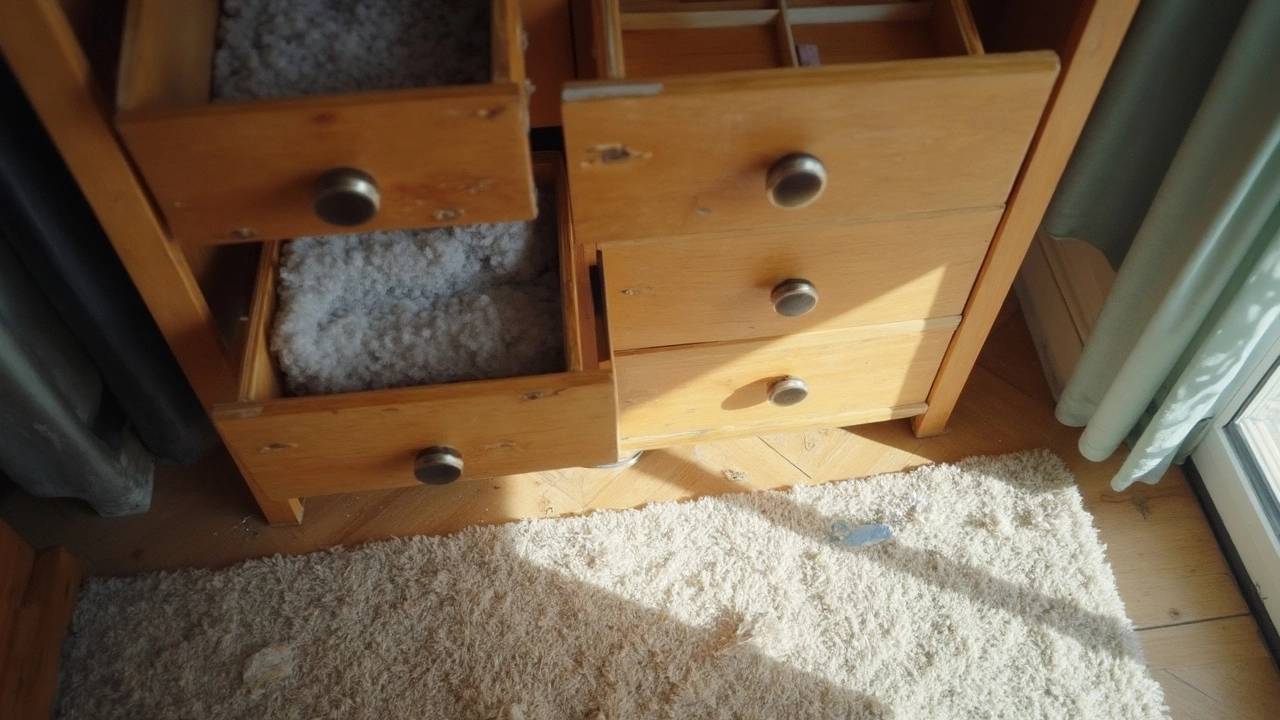Mice love sneaking into storage furniture. Why? It’s simple: these spaces are quiet, dark, and usually filled with stuff to nibble and hide inside. If you’re finding droppings or hearing scratching from your storage cabinets or closets, you’re not alone. They can chew through cardboard, fabric, and even some plastics just to get comfy.
But the good news is, it’s not hard to make your storage furniture a no-go zone for mice. Certain smells like peppermint, ammonia, and even dryer sheets make mice turn up their noses and scurry away. Stuffing a few cotton balls with peppermint oil near storage bins? That can actually keep them at bay.
- Why Mice Love Storage Furniture
- Scents and Materials that Drive Mice Away
- Making Storage Spaces Less Inviting
- Mouse-Proof Furniture: What Works Best
- DIY Hacks to Keep Mice Out
- Quick Action Steps When You Spot a Mouse
Why Mice Love Storage Furniture
Ever wonder why mice seem to pick your storage furniture over almost any spot in the house? It’s not personal—they just like what these areas offer. Storage furniture checks all the boxes for what a mouse wants: warmth, shelter, and something to chew on. Old dressers, closets, and cabinets turn into the perfect mini playgrounds for them.
Mice like places that are quiet and rarely disturbed. If you haven’t opened that storage ottoman in a month, chances are a mouse has already scoped it out. Clutter inside—think stacks of clothes, spare linens, or even books—means more places for mice to stay hidden and safe from predators or the family cat.
You probably already know mice can chew through just about anything. If your storage furniture is made of wood, fabric, or thin plastic, it’s like an open invitation. Mice use these materials for nesting, and the damage can add up quickly. A report from the National Pest Management Association found that mice can squeeze through a hole as tiny as a dime, which means that even small gaps or loose bottoms on furniture can be enough for them to get in.
| What Draws Mice In | Reality Check |
|---|---|
| Warm, dark spaces | Storage units rarely get light or air |
| Plenty of hiding spots | Extra boxes and clutter make perfect cover |
| Easy-to-chew materials | Wood and fabric are a mouse’s dream |
| Food or food smells | Forgotten snacks invite uninvited guests |
If you store pet food, snacks, or bird seed, even “sealed” in a flimsy bag, that’s basically a dinner bell. Once a mouse finds food, it keeps coming back and can invite the whole family. One female can have up to 10 litters a year, so a single oversight can become a big problem fast.
Bottom line: if storage furniture is cozy, cluttered, and filled with chewable stuff, mice will want in. Understanding why they show up is the first step to kicking them out for good.
Scents and Materials that Drive Mice Away
If there’s one thing mice can’t stand, it’s certain strong smells. Their little noses are way more sensitive than ours. Experts often mention peppermint as top of the list. Put a few drops of peppermint oil on cotton balls and tuck them into your storage furniture. You’ll notice that mice keep away, probably grumbling about the smell if they could talk.
Ammonia is another one. It works because mice think the scent means a big predator (like a cat) might be around. But use caution—ammonia is strong for humans, too, and you don’t want to accidentally overpower your own space. Cinnamon, clove oil, and even vinegar can be decent backup choices. Some folks even toss dryer sheets into drawers and boxes. There are mixed reviews, but many swear by them, saying the fresh smell drives mice nuts (not in a good way).
If you want a quick look at how these smells stack up, here’s a simple table:
| Scent/Material | Mouse Repellent Rating | Notes for Use |
|---|---|---|
| Peppermint oil | Excellent | Easy to use; helps mask food smells |
| Ammonia | Very good | Powerful but use sparingly due to harshness |
| Cinnamon/Cloves | Good | Can be added to sachets or sprinkled lightly |
| Dryer sheets | Decent | Simple placement, needs renewal weekly |
| Vinegar | Temporary | Smell fades quickly, so reapply often |
Avoid putting food, pet treats, or grains anywhere near your storage bins or cabinets—mice can sniff them out in minutes, and even the strongest peppermint won't help if there's real food around. For materials, ditch cardboard if possible. Mice chew through it like it’s a snack. Go with metal or hard plastic containers instead. Wood furniture is better than cardboard but can still get gnawed if mice are really desperate.
Layering these tricks—scents plus sturdy materials—makes it way tougher for rodents to make your storage furniture their new hotel. No high-tech gadgets needed, just a few proven steps and some supplies you probably already have at home.
Making Storage Spaces Less Inviting
If you want mice out, you have to make your storage spots boring—no food, no shelter, no reason to stay. Mice go wherever they find crumbs, spills, or mess; in fact, the National Pest Management Association found that over 29% of rodent problems start in cluttered storage areas. See how easy fixable this is?
First off, ditch cardboard boxes. Mice chew right through them like potato chips. Use sealed plastic bins instead. The tighter the lid, the better. Next, check all your cabinets and chests for holes or cracks; mice squeeze through gaps as thin as a pencil. Even tiny spaces matter—patch them with steel wool or metal mesh, not foam or caulk.
If you store anything edible (that includes pet food, birdseed, or even old snacks!), keep it in airtight containers. Forget the "out of sight, out of mind" trick—mice will sniff out the smallest treat.
- Tidy up any spilled grains or snacks right away.
- Keep clothes and linens in vacuum-sealed bags.
- Don’t stack boxes against walls—give at least a few inches of space behind and below so mice can’t hide.
- Check that doors and drawers close snugly; replace any worn seals or weather stripping.
Just cleaning once isn’t enough. Set a monthly calendar reminder to give your storage furniture a quick sweep for crumbs, dust, and droppings. Keeping things fresh forces mice to look elsewhere.
| Storage Type | Mouse Risk | Best Practice |
|---|---|---|
| Cardboard Boxes | High | Switch to sealed plastic bins |
| Wooden Cabinets (unsealed) | Medium | Seal cracks, use metal patches |
| Metal Lockers | Low | Check vent covers and seals |
| Plastic Bins (sealed) | Lowest | Keep lids tight, elevated off floor |
It takes a little work, but mice don’t stick around where they can’t eat or nest. The less welcoming your storage, the quicker you send them packing.

Mouse-Proof Furniture: What Works Best
So what really works when it comes to keeping mice out of your storage furniture? The material matters a lot. Wood, fabric, and plastic are like an open invitation for a mouse—they chew right through. If you want a true barrier, go for metal. Stainless steel cabinets, metal lockers, or even wire mesh shelves stop mice in their tracks. They just can’t gnaw through it.
Mice will try almost anything to find food or a home, but storage that’s tightly sealed is a game-changer. Pieces with locking lids or tightly fitted doors help a ton. Even adding weather stripping to cabinet edges can seal those tiny gaps mice squeeze through.
- Metal lockers and cabinets: best for garages, basements, and sheds.
- Plastic that’s thick and has locking lids: decent indoors, but keep it high off the floor.
- Wire mesh shelving: great for closets—lets you see what's inside and blocks bigger pests too.
- Old wooden trunks and cardboard boxes: not even close to mouse-proof.
One thing people don’t realize: mice only need a hole the size of a pencil eraser to squeeze in. Always check for little gaps around the backs and bottoms of furniture. You can use steel wool to stuff these spots—mice won’t bother with it at all.
Just take a look at how the most common types of storage stack up for mouse resistance:
| Furniture Type | Mouse Resistance |
|---|---|
| Stainless Steel Locker | Excellent |
| Wire Mesh Shelf | Very Good |
| Thick Plastic Bin (with lock) | Good (indoors) |
| Wood Cabinet | Poor |
| Cardboard Box | Useless |
If you want simple, just remember: the harder it is for you to poke a hole in the furniture, the harder it is for a mouse. Keeping storage up off the ground—on shelves, not the floor—also cuts your risk since mice aren’t as bold out in the open. Prioritize solid material, tight seals, and regular checks, and you’ll see a lot fewer furry visitors.
DIY Hacks to Keep Mice Out
If you want to keep mice away from your storage furniture, you actually don’t need expensive gear or fancy sprays. Most solutions are straight from your kitchen or hardware store. Here’s how to make your space a lot less tempting for any mouse looking for a new place to crash.
- Seal Up Any Gaps or Holes: Mice can squeeze through gaps as small as 1/4 inch. Use steel wool and caulk, or stuff copper mesh in holes and cracks. Regular foam or tape won’t cut it—they’ll chew right through.
- Peppermint Oil Cotton Balls: Soak cotton balls in peppermint oil and place them inside drawers, cabinets, or on shelves. Mice hate the smell and often turn around right there.
- Use Airtight Storage Bins: Skip the cardboard and choose plastic containers with tight lids. Label your bins so you’re not tempted to leave lids cracked open.
- No Crumbs Policy: Wipe out storage drawers and cabinets regularly. Even tiny crumbs can attract mice, so vacuum or wipe down spaces every few weeks.
- DIY Repellent Spray: Mix water, a few drops of dish soap, and about a tablespoon of peppermint or eucalyptus oil in a spray bottle. Spritz it along baseboards and in corners of your storage furniture.
Here’s what a pro says about the importance of keeping storage clean:
“Cluttered storage areas with food or fabrics are mouse magnets. Regularly cleaning and using sealed containers is the simplest, most effective way to keep rodents at bay.” — Jason Forester, Certified Pest Control Specialist
If you’re a numbers guy, check this out:
| Method | Success Rate (Est.) | Cost Level |
|---|---|---|
| Sealing gaps (steel wool/copper mesh) | 95% | Low |
| Peppermint oil cotton balls | 75% | Low |
| Airtight plastic bins | 90% | Medium |
| Regular cleaning | 85% | Low |
| DIY repellent sprays | 70% | Low |
Most of these tricks are simple, don’t cost much, and you don’t need a handyman. Don’t go overboard—pick two or three ideas and actually stick with them. Just that will cut your mouse problem down a ton.
Quick Action Steps When You Spot a Mouse
The moment you see a mouse near your storage furniture, it’s time to act—fast. You don’t want to give a single mouse the chance to invite its buddies. Mice can squeeze into holes as small as a dime and chew their way into soft materials, so ignoring them only makes things worse.
- Storage furniture check: Take everything out of the cabinets, chests, or shelves. Look for droppings, shredded materials, or bits of food. These are dead giveaways that you’ve got more than one visitor.
- Plug up holes: Use steel wool or wire mesh to block any gaps or cracks you find, especially around the back or bottom of furniture. Mice can't chew through metal.
- Set traps right away. Snap traps baited with peanut butter are quick and effective. Place them along walls or dark corners—mice love sticking close to edges.
- Clean like you mean it: Vacuum and wipe every surface. Even a few crumbs can keep mice coming back. Toss anything that’s chewed or contaminated.
- Use repellents: After cleaning, put out natural deterrents like peppermint oil or store-bought rodent spray. Reapply every few days until you’re mouse-free.
- Log your findings so you can track patterns. Did you see chewed corners? Droppings in one spot? Knowing helps you stay ahead of a repeat visit.
Curious how big a deal this is? Check out the numbers below. Mice reproduce quickly and a single female can have up to 10 litters a year. That means if you wait even a couple weeks, you could go from one mouse to twenty without realizing it.
| Mouse Fact | Number |
|---|---|
| Litters per year | Up to 10 |
| Average babies per litter | 6–8 |
| Time to maturity | 6 weeks |
If you’re overwhelmed, don’t hesitate to call pest control. Sometimes, you need the pros, especially if you spot more signs after your first cleanup. But most of the time, these steps knock out the problem before it spikes out of control.



